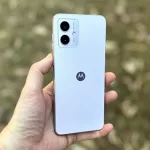
The Aspera AS5’s most remarkable feature is just how inexpensive it is. That does bring with it some notable compromises, however.
| Pros | Cons |
|---|---|
| It doesn’t cost much | Battery life is genuinely sub-par |
| Removable battery | Ordinary camera |
| Includes a headphone jack | MicroUSB charging |
Score: 3/5
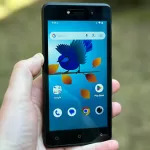 |
Buy The Aspera AS5! | Buy On Amazon |
When I write about “budget” phones, it’s typically relating to phones that can be bought outright for under $400 or so, though that figure is hardly set in stone.
However, there’s realistically another tier beneath budget, because once you dip under about $150, you’re talking truly inexpensive phones. I’m wary of using the word “cheap” here, because it brings with it connotations of being poorly made. Anything that just costs less isn’t automatically badly made, but any lower-cost phone typically brings with it a few compromises along the way.
What about a phone that costs under $100? That’s the selling proposition of the Aspera AS5, because any way you slice it, $99 for a phone is indeed cheap. The odds are incredibly good that any medium-term user of a $99 phone is going to spend more on phone service than on the phone itself – but only if the phone itself stands up as good value.
The Aspera AS5 is mostly fine, with rather predictable compromises, and one particular weak point that makes it less compelling, and that’s battery life.
Design

Pulling the Aspera AS5 out of the box felt a little like going back in time, because in design terms this is very much what phones looked like about eight years ago… maybe even longer. It’s built around a 5 inch 854×480 pixel LCD display, which isn’t on the sharp side… but remember again, this is a $99 phone, so it’s within expectations. It also features a really thick bezel around that screen, which is what gives it that distinctly retro styled look.
From a practical viewpoint – and to give no real secrets away whatsoever – while Aspera Mobile is an Australian company, it’s not like they’ve got a factory in, say, Wagga Wagga churning out phones. The Aspera AS5 has come from a Chinese factory using a reference design to keep costs low, which is why it’s so relatively inexpensive. One of the ways you see that is in the design, which really only expands to a band on the back with the company logo at the base. Methinks you could probably find the AS5 with other brand names on it in other markets.
What you do find with the Aspera AS5 that you don’t with too many lower priced phones is full dual SIM capability. They’re both 4G only – 5G hasn’t quite become that inexpensive yet – and there’s no messing around with a choice of microSD or SIM cards, because there’s also a microSD card slot beneath the removable back.
The Aspera AS5 also has a proper 3.5mm headphone jack for those that prefer wired headphones. You even get a set in the box, though predictably they’re not particularly good in any real way. It’s still a nice feature to have, and extra headphones are still extra value too.
In terms of biometrics, Aspera touts that the Aspera AS5 has facial unlocking, not common in phones at this price point.
They’re right about the price point, but it is super important to point out that it’s just using flat pattern recognition to unlock, which is not particularly secure. If you’re concerned about security on this phone, use a PIN code instead. Face unlock works, but this type of facial recognition is all too easily fooled.
Camera
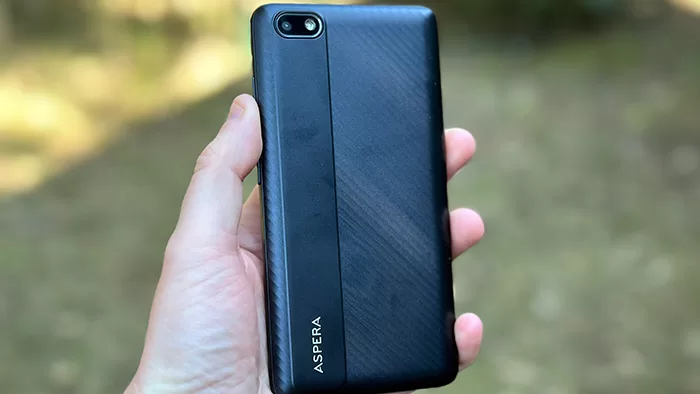
In the budget space, the most common way to cut costs is to incorporate lower-end camera modules. The Aspera AS5 certainly fits that bill in numerical terms, with 5MP front and rear cameras and… that’s it.
That doesn’t represent a lot of flexibility, but I’m again drawn back to that $99 price point. If you want additional cameras, you are flat out going to have to pay just a little bit more for them.
They’re certainly a huge step up from the 0.3MP camera module on the recently reviewed Nokia 2660 Flip – and that’s a phone that costs more than the Aspera AS5 in the first place!
Also read:
Nokia 2660 Flip Review
Rather predictably, the shooting quality on the Aspera AS5 isn’t too much to get excited by. It’s a slow camera to start and a very slow camera to shoot with, especially if you’re using features like its portrait mode.
In some ways it’s impressive to just see a portrait mode on a $99 camera, and in decent light it’s OK, but as soon as you push it for motion or lighting conditions you see where it’s truly limited.
Aspera AS5 Sample Photos
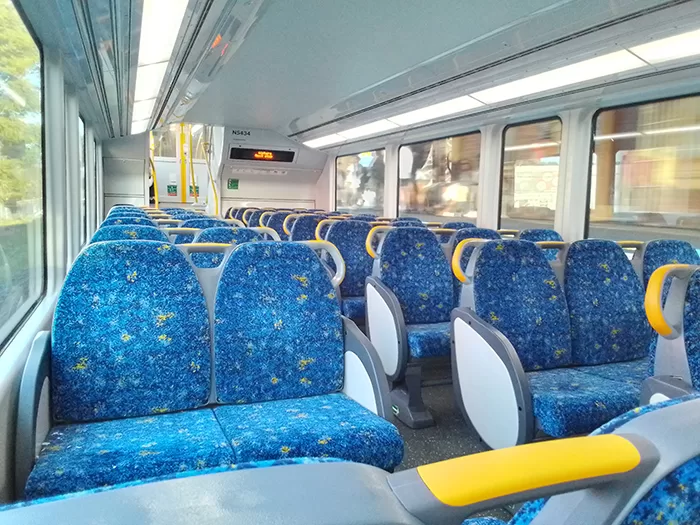





Performance

The Aspera AS5 is built around an octa-core 1.6Ghz processor with 2GB of RAM. Aspera Mobile doesn’t state what it is, but CPU-Z suggests that it’s probably the Unisoc 9863A, a somewhat older processor system, but one that’s still 4G capable.
So what do you do when you’ve got a low-spec processor and not much RAM on an Android phone?
If you’re smart, you throw Android Go on it. For the uninitiated, Android Go is the ultra-optimised version of the regular Android OS built for low-power phones. That’s why you’ll find Android 13 Go on the Aspera AS5, along with optimised versions of regular Android apps that should run a little better within its processing constraints.
Not that this means that you can’t run any other Android app on the AS5, or at least try to do so. This isn’t a fast phone, and that’s absolutely to be expected at this $99 price point. It wouldn’t run Geekbench 6 – app makers can specify minimum specs for their apps and the Aspera AS5 doesn’t meet them – and its 3DMark Slingshot Extreme Score puts it on a par with something like 2021’s Motorola Moto e7 Power.
Also Read:
Motorola Moto e7 Power Review (Finder)
The Aspera AS5 was, during my review period, only up to date with the May 2023 Android security updates, which is a bit of a concern if you were looking to use this phone long term for sensitive information tasks like banking. It’s not unusual again for cheaper phones to have a slightly spotty update schedule, if they have one at all.
Battery
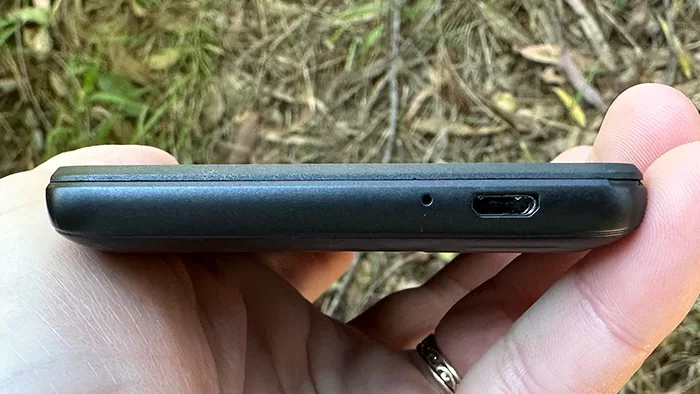
I should start talking about the battery on the Aspera AS5 by noting its most unusual feature. The Aspera AS5 features a removeable battery, and that’s a truly unusual inclusion for any Android phone in this day and age. It opens the prospect of replacement down the track if the battery starts to fail.
However, it’s also astonishingly small. It’s just a 2,000mAh battery pack in a market where nearly every Android phone on the market has 4,000mAh batteries, and 5,000mAh is fast becoming the accepted norm. 2,000mAh doesn’t give the Aspera AS5 a lot of breathing room for battery endurance, but then it is running on a very low end processor. So how does it compare for battery life?
Badly.
Battery life is always relative, but to give it some context, I ran it through my standard battery life test, running a YouTube video for an hour from a fully charged battery.
The AS5 gets off somewhat lightly here as preferentially I run that video at 1080p, but the AS5’s screen can’t manage that at all. Typically any phone that can’t retain 90% of its battery capacity after that hour is a phone that is likely to struggle with a full day’s moderate usage.
After an hour of testing, the Aspera AS5 had just 67% battery life left.
Multiple test runs gave the same basic result, which suggests that if this is a phone that you want and you’re going to be using frequently, you’re going to struggle to last out a day.
I could throw up a chart of comparative values here against other current smartphones, but it would feel like I was mugging the Aspera AS5 and picking through its pockets for loose change, because it’s one of the lowest scores for this test I’ve ever recorded.
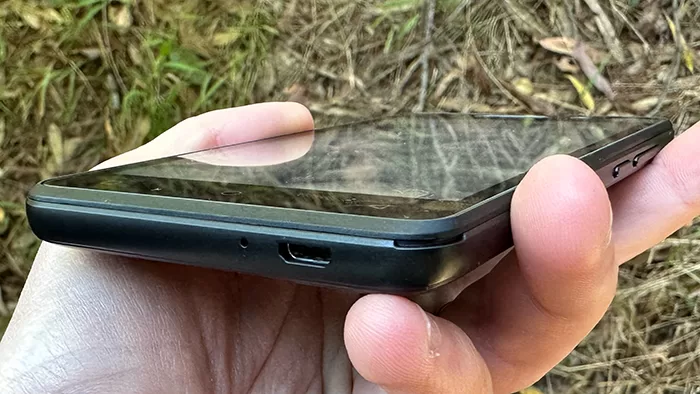
I did test out seeing how the Aspera AS5 managed on much less usage – for, say, someone who wanted a phone first and apps second – and it managed a little better, but not by much.
Aspera does supply a charger in the box, which is nice, but then the Aspera AS5 is one of the first smartphones I’ve tested for a long while to use the older microUSB charging standard.
I’ve got quite a few cables lurking around my office – the perils of being a long-term tech journo – but even I’m starting to have to hunt and peck around for microUSB cables. USB-C is far more standard these days, and it’s worth noting that the Aspera AS8 that I tested alongside the AS5 is USB-C capable.
Aspera AS5: Alex’s Verdict

The Aspera AS5 is remarkable for its price, and that’s its core selling proposition. If you just want a very basic phone and you aren’t all that fussed about photography or fast app launching it will mostly get the job done.
There’s no doubt that you can get better for not that much more money, and if your budget can stretch to it, then I’d recommend you do so, especially given the Aspera AS5’s poor battery performance.
Still, there absolutely is a market for this kind of no-frills phone for folks who don’t want to spend a lot on a phone or just need a simple contact device.
It would make a decent kid’s phone – if they break it it’s less of a drama and the constrained battery life might even be a plus – or option for the less tech-inclined smartphone user on a tight budget.
Aspera AS5: Pricing and availability
The Aspera AS5 retails in Australia for $99 outright.
 |
Buy The Aspera AS5! | Buy On Amazon |








